Nursing Management: Integrated Care Model for Chronic Illness
VerifiedAdded on 2020/03/16
|9
|2123
|37
Report
AI Summary
This nursing management report presents a case study of Daniel, who suffers from acute myocardial infarction (AMI) and explores the implications of his condition on his family and the need for suitable care. The report identifies potential chronic illnesses associated with Daniel's condition, such as obesity, diabetes, and high blood pressure, and their impact. It then proposes the Integrated Care Model, specifically the Patient-Centered Medical Home model, as the most appropriate care model for Daniel, highlighting its benefits in coordinating care, involving family members, and ensuring continuous patient support. The report includes sample documentation like a patient communication letter and a referral letter, demonstrating the practical application of the care model. The report also highlights the financial and social challenges that chronic illnesses pose to patients and their families and emphasizes the importance of coordinated and proactive care to improve patient outcomes and family well-being.

1
Running Head: Nursing Management
Nursing Assignment
Institution
Lecturer
Student
Course
Date
Running Head: Nursing Management
Nursing Assignment
Institution
Lecturer
Student
Course
Date
Paraphrase This Document
Need a fresh take? Get an instant paraphrase of this document with our AI Paraphraser
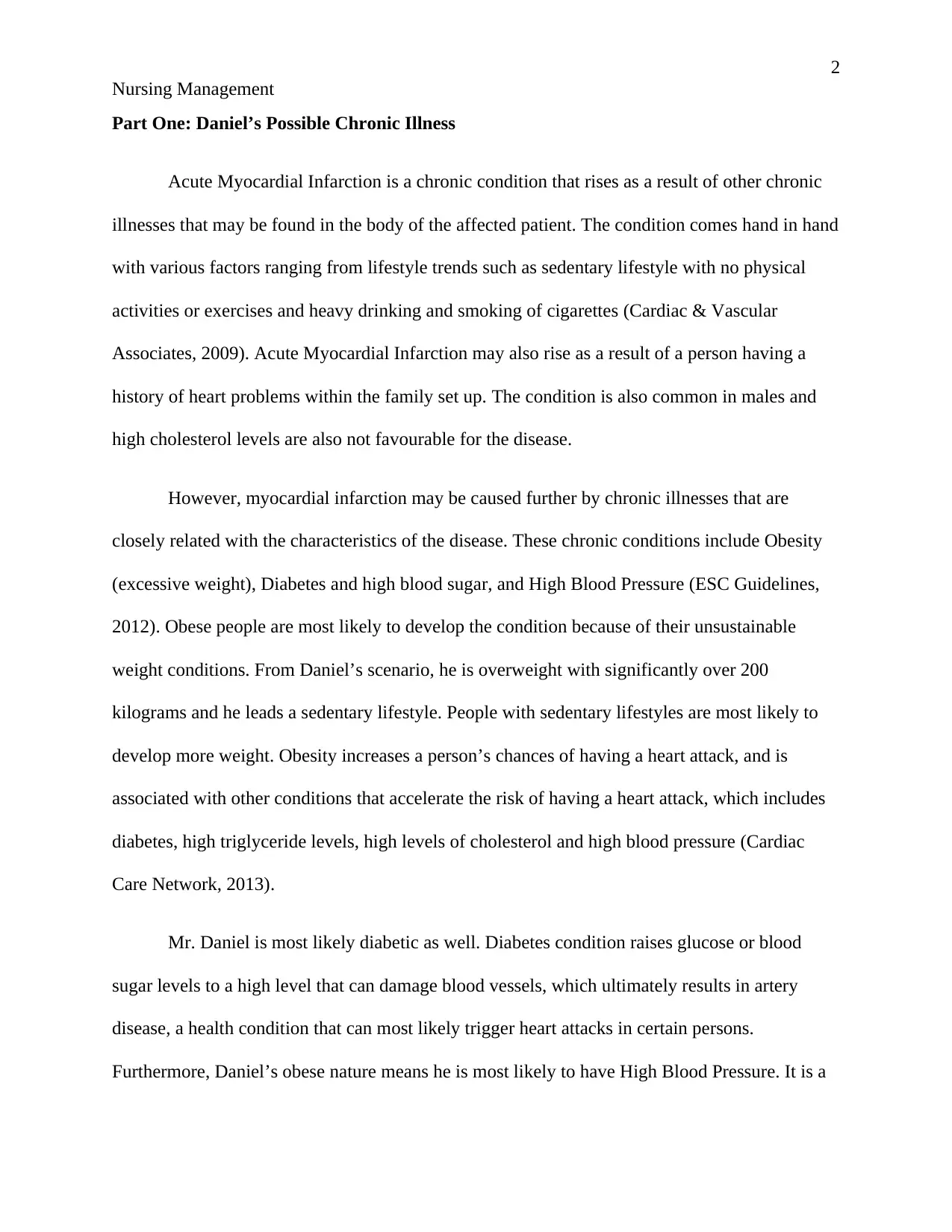
2
Nursing Management
Part One: Daniel’s Possible Chronic Illness
Acute Myocardial Infarction is a chronic condition that rises as a result of other chronic
illnesses that may be found in the body of the affected patient. The condition comes hand in hand
with various factors ranging from lifestyle trends such as sedentary lifestyle with no physical
activities or exercises and heavy drinking and smoking of cigarettes (Cardiac & Vascular
Associates, 2009). Acute Myocardial Infarction may also rise as a result of a person having a
history of heart problems within the family set up. The condition is also common in males and
high cholesterol levels are also not favourable for the disease.
However, myocardial infarction may be caused further by chronic illnesses that are
closely related with the characteristics of the disease. These chronic conditions include Obesity
(excessive weight), Diabetes and high blood sugar, and High Blood Pressure (ESC Guidelines,
2012). Obese people are most likely to develop the condition because of their unsustainable
weight conditions. From Daniel’s scenario, he is overweight with significantly over 200
kilograms and he leads a sedentary lifestyle. People with sedentary lifestyles are most likely to
develop more weight. Obesity increases a person’s chances of having a heart attack, and is
associated with other conditions that accelerate the risk of having a heart attack, which includes
diabetes, high triglyceride levels, high levels of cholesterol and high blood pressure (Cardiac
Care Network, 2013).
Mr. Daniel is most likely diabetic as well. Diabetes condition raises glucose or blood
sugar levels to a high level that can damage blood vessels, which ultimately results in artery
disease, a health condition that can most likely trigger heart attacks in certain persons.
Furthermore, Daniel’s obese nature means he is most likely to have High Blood Pressure. It is a
Nursing Management
Part One: Daniel’s Possible Chronic Illness
Acute Myocardial Infarction is a chronic condition that rises as a result of other chronic
illnesses that may be found in the body of the affected patient. The condition comes hand in hand
with various factors ranging from lifestyle trends such as sedentary lifestyle with no physical
activities or exercises and heavy drinking and smoking of cigarettes (Cardiac & Vascular
Associates, 2009). Acute Myocardial Infarction may also rise as a result of a person having a
history of heart problems within the family set up. The condition is also common in males and
high cholesterol levels are also not favourable for the disease.
However, myocardial infarction may be caused further by chronic illnesses that are
closely related with the characteristics of the disease. These chronic conditions include Obesity
(excessive weight), Diabetes and high blood sugar, and High Blood Pressure (ESC Guidelines,
2012). Obese people are most likely to develop the condition because of their unsustainable
weight conditions. From Daniel’s scenario, he is overweight with significantly over 200
kilograms and he leads a sedentary lifestyle. People with sedentary lifestyles are most likely to
develop more weight. Obesity increases a person’s chances of having a heart attack, and is
associated with other conditions that accelerate the risk of having a heart attack, which includes
diabetes, high triglyceride levels, high levels of cholesterol and high blood pressure (Cardiac
Care Network, 2013).
Mr. Daniel is most likely diabetic as well. Diabetes condition raises glucose or blood
sugar levels to a high level that can damage blood vessels, which ultimately results in artery
disease, a health condition that can most likely trigger heart attacks in certain persons.
Furthermore, Daniel’s obese nature means he is most likely to have High Blood Pressure. It is a
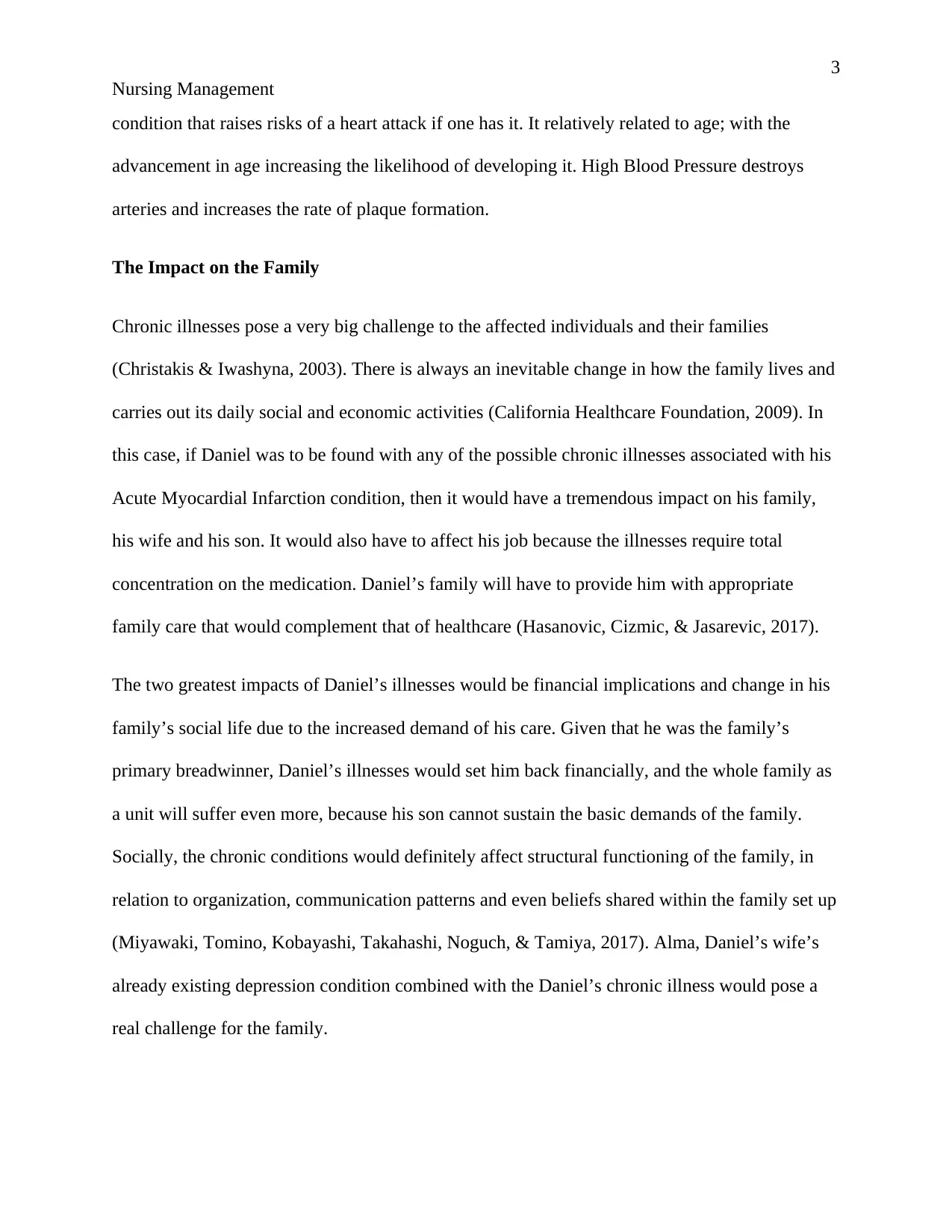
3
Nursing Management
condition that raises risks of a heart attack if one has it. It relatively related to age; with the
advancement in age increasing the likelihood of developing it. High Blood Pressure destroys
arteries and increases the rate of plaque formation.
The Impact on the Family
Chronic illnesses pose a very big challenge to the affected individuals and their families
(Christakis & Iwashyna, 2003). There is always an inevitable change in how the family lives and
carries out its daily social and economic activities (California Healthcare Foundation, 2009). In
this case, if Daniel was to be found with any of the possible chronic illnesses associated with his
Acute Myocardial Infarction condition, then it would have a tremendous impact on his family,
his wife and his son. It would also have to affect his job because the illnesses require total
concentration on the medication. Daniel’s family will have to provide him with appropriate
family care that would complement that of healthcare (Hasanovic, Cizmic, & Jasarevic, 2017).
The two greatest impacts of Daniel’s illnesses would be financial implications and change in his
family’s social life due to the increased demand of his care. Given that he was the family’s
primary breadwinner, Daniel’s illnesses would set him back financially, and the whole family as
a unit will suffer even more, because his son cannot sustain the basic demands of the family.
Socially, the chronic conditions would definitely affect structural functioning of the family, in
relation to organization, communication patterns and even beliefs shared within the family set up
(Miyawaki, Tomino, Kobayashi, Takahashi, Noguch, & Tamiya, 2017). Alma, Daniel’s wife’s
already existing depression condition combined with the Daniel’s chronic illness would pose a
real challenge for the family.
Nursing Management
condition that raises risks of a heart attack if one has it. It relatively related to age; with the
advancement in age increasing the likelihood of developing it. High Blood Pressure destroys
arteries and increases the rate of plaque formation.
The Impact on the Family
Chronic illnesses pose a very big challenge to the affected individuals and their families
(Christakis & Iwashyna, 2003). There is always an inevitable change in how the family lives and
carries out its daily social and economic activities (California Healthcare Foundation, 2009). In
this case, if Daniel was to be found with any of the possible chronic illnesses associated with his
Acute Myocardial Infarction condition, then it would have a tremendous impact on his family,
his wife and his son. It would also have to affect his job because the illnesses require total
concentration on the medication. Daniel’s family will have to provide him with appropriate
family care that would complement that of healthcare (Hasanovic, Cizmic, & Jasarevic, 2017).
The two greatest impacts of Daniel’s illnesses would be financial implications and change in his
family’s social life due to the increased demand of his care. Given that he was the family’s
primary breadwinner, Daniel’s illnesses would set him back financially, and the whole family as
a unit will suffer even more, because his son cannot sustain the basic demands of the family.
Socially, the chronic conditions would definitely affect structural functioning of the family, in
relation to organization, communication patterns and even beliefs shared within the family set up
(Miyawaki, Tomino, Kobayashi, Takahashi, Noguch, & Tamiya, 2017). Alma, Daniel’s wife’s
already existing depression condition combined with the Daniel’s chronic illness would pose a
real challenge for the family.
⊘ This is a preview!⊘
Do you want full access?
Subscribe today to unlock all pages.

Trusted by 1+ million students worldwide

4
Nursing Management
Part Two: Daniel’s Suitable Care Model
Daniel’s health conditions in relation to his family background, requires a very suitable
care model that would suit his lifestyle at the same time deliver the kind of care that he needs in
the management of his medical conditions. Therefore, in this case, the most appropriate care
model that would suit the patient is Integrated Care Model (World Health Organization, 2016).
The care model is more inclusive and involves all the stakeholders, the medical professional, the
family and policy regulators among others in the provision of the care to the patients.
By revisiting Daniel’s life, there are a lot of factors that have to be considered to provide
him with the best patient care. He is suffering from a chronic condition with a possibility of other
complications and illnesses that are associated with the condition and he is the primary
breadwinner, as his wife is not working anymore after losing her job. It means his whole family
unit is dependent on him.
The advancing years of Daniel and his financial status combined with his social
behaviors and health conditions implies, integrated care would provide the necessary blend of
home care and social care within the community and meet all the requirements of the patient and
his family (Almgren & Diwan). The importance of integrated care is that it is extremely
coordinated and it ensures the continuity of the care for the patient because of clearly defined set
of care which pathways that support each other.
In the integrated care model, family members are involved fully as they provide the basis
for the patient including explaining the medical conditions to the physician. They also provide
with the support by implementing all the required medical needs for the patient from physician.
Nursing Management
Part Two: Daniel’s Suitable Care Model
Daniel’s health conditions in relation to his family background, requires a very suitable
care model that would suit his lifestyle at the same time deliver the kind of care that he needs in
the management of his medical conditions. Therefore, in this case, the most appropriate care
model that would suit the patient is Integrated Care Model (World Health Organization, 2016).
The care model is more inclusive and involves all the stakeholders, the medical professional, the
family and policy regulators among others in the provision of the care to the patients.
By revisiting Daniel’s life, there are a lot of factors that have to be considered to provide
him with the best patient care. He is suffering from a chronic condition with a possibility of other
complications and illnesses that are associated with the condition and he is the primary
breadwinner, as his wife is not working anymore after losing her job. It means his whole family
unit is dependent on him.
The advancing years of Daniel and his financial status combined with his social
behaviors and health conditions implies, integrated care would provide the necessary blend of
home care and social care within the community and meet all the requirements of the patient and
his family (Almgren & Diwan). The importance of integrated care is that it is extremely
coordinated and it ensures the continuity of the care for the patient because of clearly defined set
of care which pathways that support each other.
In the integrated care model, family members are involved fully as they provide the basis
for the patient including explaining the medical conditions to the physician. They also provide
with the support by implementing all the required medical needs for the patient from physician.
Paraphrase This Document
Need a fresh take? Get an instant paraphrase of this document with our AI Paraphraser
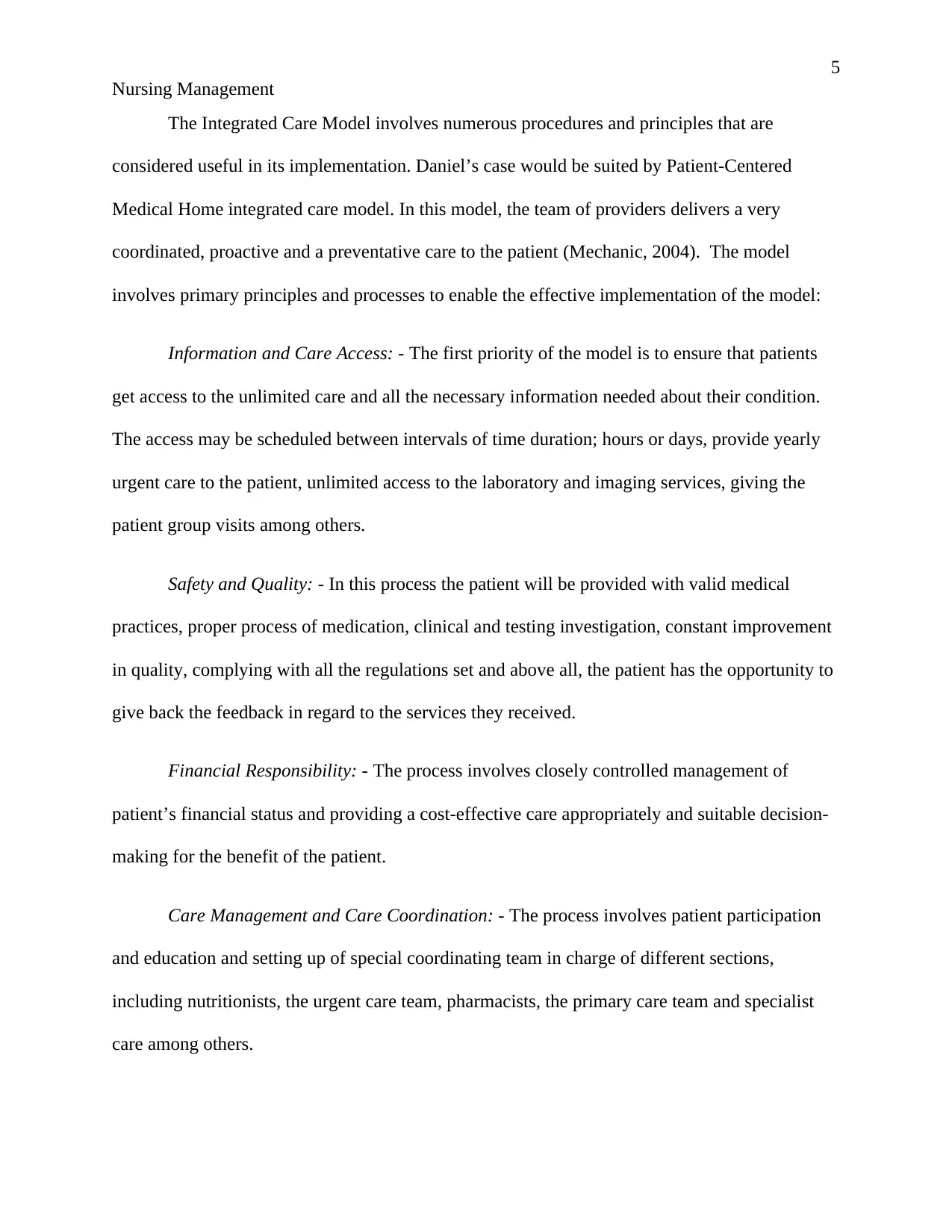
5
Nursing Management
The Integrated Care Model involves numerous procedures and principles that are
considered useful in its implementation. Daniel’s case would be suited by Patient-Centered
Medical Home integrated care model. In this model, the team of providers delivers a very
coordinated, proactive and a preventative care to the patient (Mechanic, 2004). The model
involves primary principles and processes to enable the effective implementation of the model:
Information and Care Access: - The first priority of the model is to ensure that patients
get access to the unlimited care and all the necessary information needed about their condition.
The access may be scheduled between intervals of time duration; hours or days, provide yearly
urgent care to the patient, unlimited access to the laboratory and imaging services, giving the
patient group visits among others.
Safety and Quality: - In this process the patient will be provided with valid medical
practices, proper process of medication, clinical and testing investigation, constant improvement
in quality, complying with all the regulations set and above all, the patient has the opportunity to
give back the feedback in regard to the services they received.
Financial Responsibility: - The process involves closely controlled management of
patient’s financial status and providing a cost-effective care appropriately and suitable decision-
making for the benefit of the patient.
Care Management and Care Coordination: - The process involves patient participation
and education and setting up of special coordinating team in charge of different sections,
including nutritionists, the urgent care team, pharmacists, the primary care team and specialist
care among others.
Nursing Management
The Integrated Care Model involves numerous procedures and principles that are
considered useful in its implementation. Daniel’s case would be suited by Patient-Centered
Medical Home integrated care model. In this model, the team of providers delivers a very
coordinated, proactive and a preventative care to the patient (Mechanic, 2004). The model
involves primary principles and processes to enable the effective implementation of the model:
Information and Care Access: - The first priority of the model is to ensure that patients
get access to the unlimited care and all the necessary information needed about their condition.
The access may be scheduled between intervals of time duration; hours or days, provide yearly
urgent care to the patient, unlimited access to the laboratory and imaging services, giving the
patient group visits among others.
Safety and Quality: - In this process the patient will be provided with valid medical
practices, proper process of medication, clinical and testing investigation, constant improvement
in quality, complying with all the regulations set and above all, the patient has the opportunity to
give back the feedback in regard to the services they received.
Financial Responsibility: - The process involves closely controlled management of
patient’s financial status and providing a cost-effective care appropriately and suitable decision-
making for the benefit of the patient.
Care Management and Care Coordination: - The process involves patient participation
and education and setting up of special coordinating team in charge of different sections,
including nutritionists, the urgent care team, pharmacists, the primary care team and specialist
care among others.
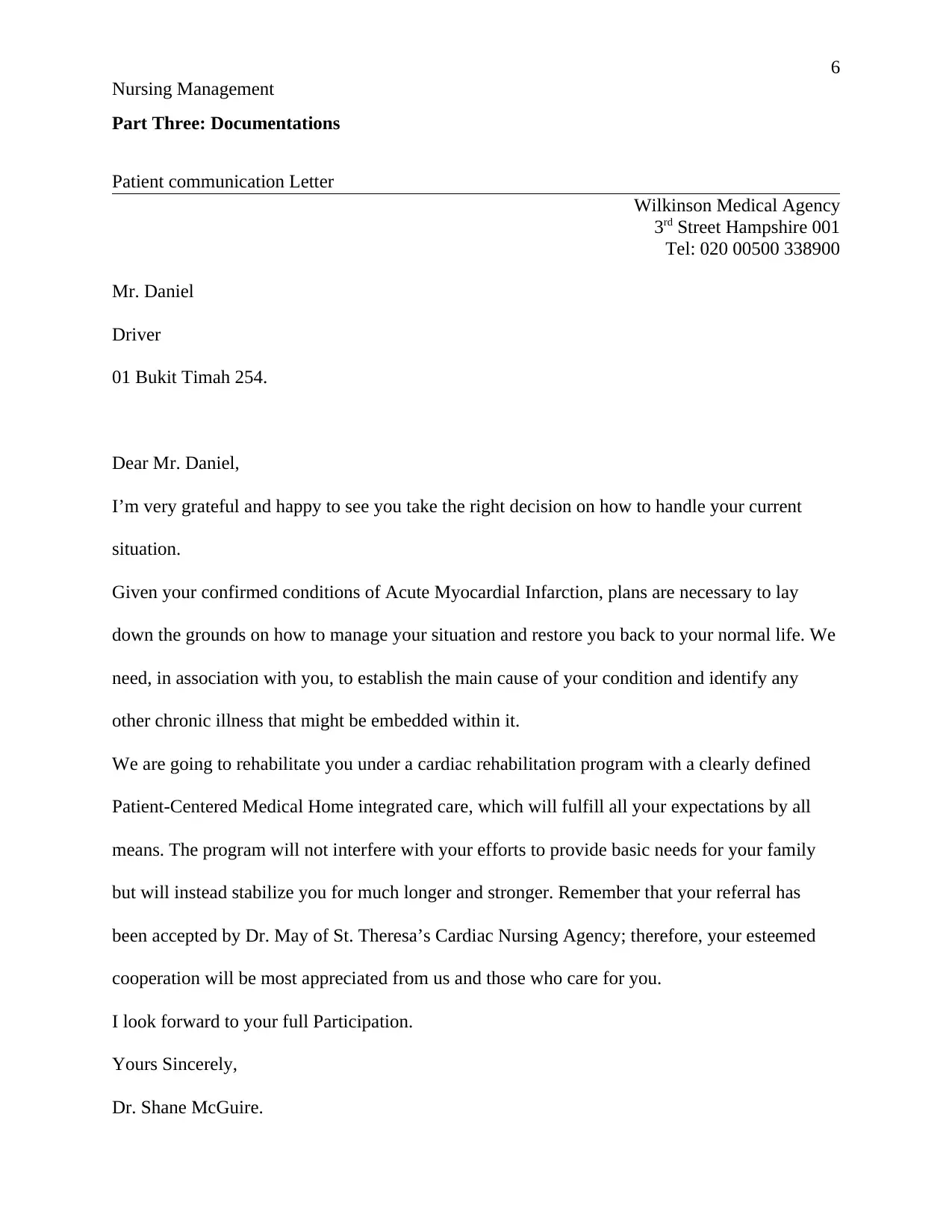
6
Nursing Management
Part Three: Documentations
Patient communication Letter
Wilkinson Medical Agency
3rd Street Hampshire 001
Tel: 020 00500 338900
Mr. Daniel
Driver
01 Bukit Timah 254.
Dear Mr. Daniel,
I’m very grateful and happy to see you take the right decision on how to handle your current
situation.
Given your confirmed conditions of Acute Myocardial Infarction, plans are necessary to lay
down the grounds on how to manage your situation and restore you back to your normal life. We
need, in association with you, to establish the main cause of your condition and identify any
other chronic illness that might be embedded within it.
We are going to rehabilitate you under a cardiac rehabilitation program with a clearly defined
Patient-Centered Medical Home integrated care, which will fulfill all your expectations by all
means. The program will not interfere with your efforts to provide basic needs for your family
but will instead stabilize you for much longer and stronger. Remember that your referral has
been accepted by Dr. May of St. Theresa’s Cardiac Nursing Agency; therefore, your esteemed
cooperation will be most appreciated from us and those who care for you.
I look forward to your full Participation.
Yours Sincerely,
Dr. Shane McGuire.
Nursing Management
Part Three: Documentations
Patient communication Letter
Wilkinson Medical Agency
3rd Street Hampshire 001
Tel: 020 00500 338900
Mr. Daniel
Driver
01 Bukit Timah 254.
Dear Mr. Daniel,
I’m very grateful and happy to see you take the right decision on how to handle your current
situation.
Given your confirmed conditions of Acute Myocardial Infarction, plans are necessary to lay
down the grounds on how to manage your situation and restore you back to your normal life. We
need, in association with you, to establish the main cause of your condition and identify any
other chronic illness that might be embedded within it.
We are going to rehabilitate you under a cardiac rehabilitation program with a clearly defined
Patient-Centered Medical Home integrated care, which will fulfill all your expectations by all
means. The program will not interfere with your efforts to provide basic needs for your family
but will instead stabilize you for much longer and stronger. Remember that your referral has
been accepted by Dr. May of St. Theresa’s Cardiac Nursing Agency; therefore, your esteemed
cooperation will be most appreciated from us and those who care for you.
I look forward to your full Participation.
Yours Sincerely,
Dr. Shane McGuire.
⊘ This is a preview!⊘
Do you want full access?
Subscribe today to unlock all pages.

Trusted by 1+ million students worldwide
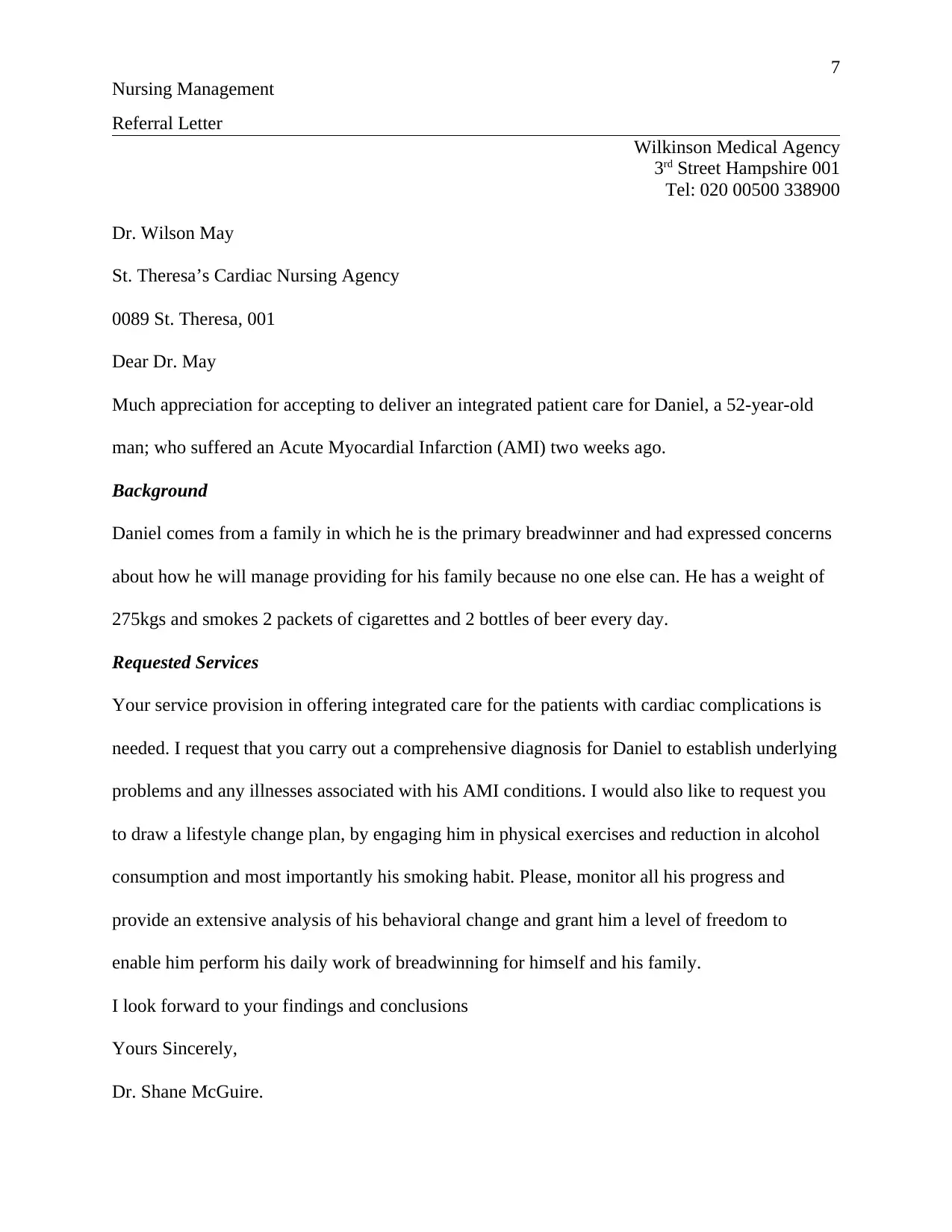
7
Nursing Management
Referral Letter
Wilkinson Medical Agency
3rd Street Hampshire 001
Tel: 020 00500 338900
Dr. Wilson May
St. Theresa’s Cardiac Nursing Agency
0089 St. Theresa, 001
Dear Dr. May
Much appreciation for accepting to deliver an integrated patient care for Daniel, a 52-year-old
man; who suffered an Acute Myocardial Infarction (AMI) two weeks ago.
Background
Daniel comes from a family in which he is the primary breadwinner and had expressed concerns
about how he will manage providing for his family because no one else can. He has a weight of
275kgs and smokes 2 packets of cigarettes and 2 bottles of beer every day.
Requested Services
Your service provision in offering integrated care for the patients with cardiac complications is
needed. I request that you carry out a comprehensive diagnosis for Daniel to establish underlying
problems and any illnesses associated with his AMI conditions. I would also like to request you
to draw a lifestyle change plan, by engaging him in physical exercises and reduction in alcohol
consumption and most importantly his smoking habit. Please, monitor all his progress and
provide an extensive analysis of his behavioral change and grant him a level of freedom to
enable him perform his daily work of breadwinning for himself and his family.
I look forward to your findings and conclusions
Yours Sincerely,
Dr. Shane McGuire.
Nursing Management
Referral Letter
Wilkinson Medical Agency
3rd Street Hampshire 001
Tel: 020 00500 338900
Dr. Wilson May
St. Theresa’s Cardiac Nursing Agency
0089 St. Theresa, 001
Dear Dr. May
Much appreciation for accepting to deliver an integrated patient care for Daniel, a 52-year-old
man; who suffered an Acute Myocardial Infarction (AMI) two weeks ago.
Background
Daniel comes from a family in which he is the primary breadwinner and had expressed concerns
about how he will manage providing for his family because no one else can. He has a weight of
275kgs and smokes 2 packets of cigarettes and 2 bottles of beer every day.
Requested Services
Your service provision in offering integrated care for the patients with cardiac complications is
needed. I request that you carry out a comprehensive diagnosis for Daniel to establish underlying
problems and any illnesses associated with his AMI conditions. I would also like to request you
to draw a lifestyle change plan, by engaging him in physical exercises and reduction in alcohol
consumption and most importantly his smoking habit. Please, monitor all his progress and
provide an extensive analysis of his behavioral change and grant him a level of freedom to
enable him perform his daily work of breadwinning for himself and his family.
I look forward to your findings and conclusions
Yours Sincerely,
Dr. Shane McGuire.
Paraphrase This Document
Need a fresh take? Get an instant paraphrase of this document with our AI Paraphraser

8
Nursing Management
References
Almgren, G., & Diwan, S. (n.d.). SECTION 3: Typology of Chronic Illness And Impact on The
Family . Council on Social Work Education , 1-13.
California Healthcare Foundation. (2009). Sharing the Care: The Role of Family in Chronic
Illness. 2-28.
Cardiac & Vascular Associates. (2009). Facts About Myocardial Infarction (Heart Attack).
Chattanooga Heart, Lung and Vascular Center , 1-4.
Cardiac Care Network. (2013). Management Of Acute CooronaryY Syndromes: Best Practice
Recommendations For Remote Communities. 2-38.
Christakis, N. A., & Iwashyna, T. J. (2003). The health impact of health care on families: a
matched cohort study of hospice use by decedents and mortality outcomes in surviving,
widowed spouses. Social Science & Medicine , 465–475.
ESC Guidelines. (2012). ESC Guidelines for the management of acute myocardial infarction in
patients presenting with ST-segment elevation . European Heart Journal , 2569–2619 .
Hasanovic, M., Cizmic, A., & Jasarevic, M. (2017). The Course of Depression Following
Myocardial Infarction and the Impact of the Social Neglect on the Recovery of the
Patient. Journal of Neurology & Stroke , 1-4.
Mechanic, R. (2004). Will Care Management Improve the Value of U.S. Health Care? . The
Health Industry Forum , 2-15.
Miyawaki, A., Tomino, J., Kobayashi, Y., Takahashi, H., Noguch, H., & Tamiya, N. (2017).
Impact of long-hours family caregiving on non-fatal coronary heart disease risk in
Nursing Management
References
Almgren, G., & Diwan, S. (n.d.). SECTION 3: Typology of Chronic Illness And Impact on The
Family . Council on Social Work Education , 1-13.
California Healthcare Foundation. (2009). Sharing the Care: The Role of Family in Chronic
Illness. 2-28.
Cardiac & Vascular Associates. (2009). Facts About Myocardial Infarction (Heart Attack).
Chattanooga Heart, Lung and Vascular Center , 1-4.
Cardiac Care Network. (2013). Management Of Acute CooronaryY Syndromes: Best Practice
Recommendations For Remote Communities. 2-38.
Christakis, N. A., & Iwashyna, T. J. (2003). The health impact of health care on families: a
matched cohort study of hospice use by decedents and mortality outcomes in surviving,
widowed spouses. Social Science & Medicine , 465–475.
ESC Guidelines. (2012). ESC Guidelines for the management of acute myocardial infarction in
patients presenting with ST-segment elevation . European Heart Journal , 2569–2619 .
Hasanovic, M., Cizmic, A., & Jasarevic, M. (2017). The Course of Depression Following
Myocardial Infarction and the Impact of the Social Neglect on the Recovery of the
Patient. Journal of Neurology & Stroke , 1-4.
Mechanic, R. (2004). Will Care Management Improve the Value of U.S. Health Care? . The
Health Industry Forum , 2-15.
Miyawaki, A., Tomino, J., Kobayashi, Y., Takahashi, H., Noguch, H., & Tamiya, N. (2017).
Impact of long-hours family caregiving on non-fatal coronary heart disease risk in
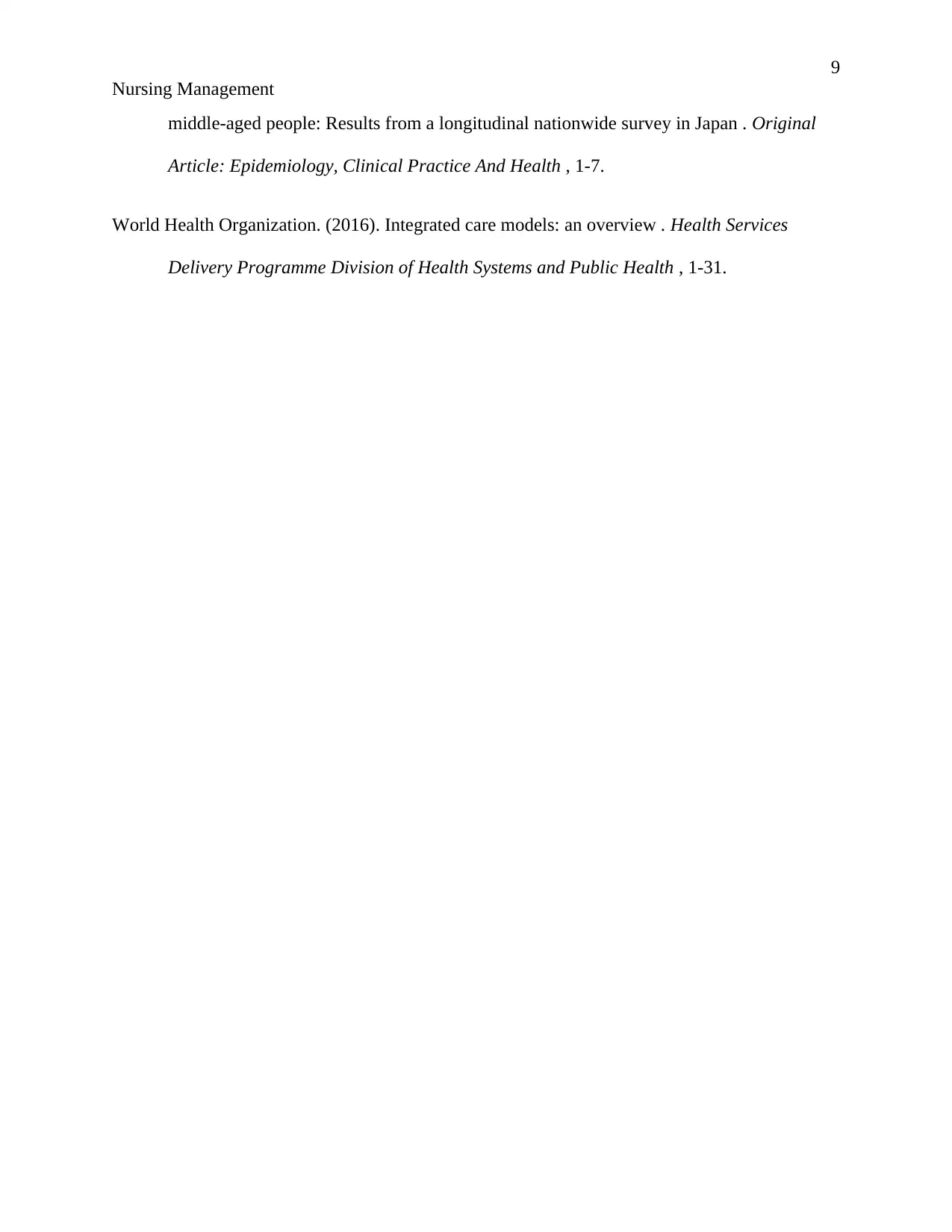
9
Nursing Management
middle-aged people: Results from a longitudinal nationwide survey in Japan . Original
Article: Epidemiology, Clinical Practice And Health , 1-7.
World Health Organization. (2016). Integrated care models: an overview . Health Services
Delivery Programme Division of Health Systems and Public Health , 1-31.
Nursing Management
middle-aged people: Results from a longitudinal nationwide survey in Japan . Original
Article: Epidemiology, Clinical Practice And Health , 1-7.
World Health Organization. (2016). Integrated care models: an overview . Health Services
Delivery Programme Division of Health Systems and Public Health , 1-31.
⊘ This is a preview!⊘
Do you want full access?
Subscribe today to unlock all pages.

Trusted by 1+ million students worldwide
1 out of 9
Related Documents
Your All-in-One AI-Powered Toolkit for Academic Success.
+13062052269
info@desklib.com
Available 24*7 on WhatsApp / Email
![[object Object]](/_next/static/media/star-bottom.7253800d.svg)
Unlock your academic potential
Copyright © 2020–2025 A2Z Services. All Rights Reserved. Developed and managed by ZUCOL.




